There are sort of two Wind Cave National Parks -- the one
above-ground that we explored this morning on the trails, and the one
below ground that is largely unexplored.Discovered in 1881 by the
Bingham brothers, Wind Cave became a national park in 1903, the first to
protect a major cave system. Over 136 miles of passageways have been
mapped in the cave so far, making Wind
Cave the third longest in the US and fifth longest in the world.
WHY "WIND" CAVE?
The cave got its name from the loud whistling noise that can often be
heard at its only natural entrance, a small hole in the ground that
rangers show visitors at the beginning of each Natural Entrance tour.
You can see how the wind still blows objects placed in front of the hole:
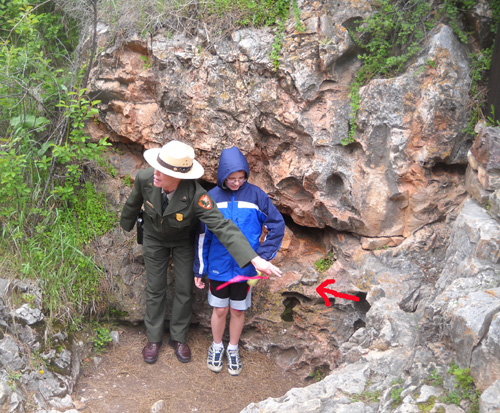
Ranger Maribeth and her helper demonstrate how much
wind is coming from the cave opening.
Now that's pretty cool!
The arrow that I drew shows the direction of the wind from the hole. See how the
red ribbon is horizontal from the breeze? The wind is created by differences between atmospheric pressures in
the cave and outside -- and it gives the cave its very apropos
name.
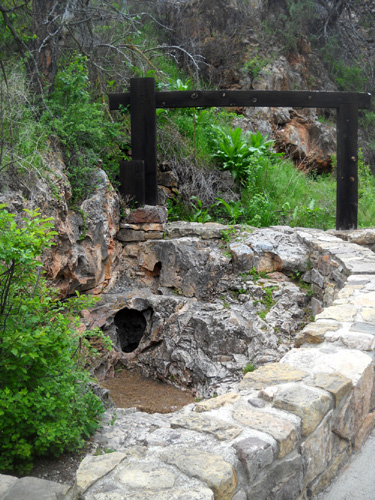
The only natural entrance to the
cave is that little hole!
Wind Cave itself is the major draw at this park, so on the one full
day we were here, we wanted to take at least one cave tour.
That didn't work out quite like we planned, after the truck key fiasco I
wrote about in the last entry. By the time we hiked an extra five miles
to track down those keys it was 2 PM. Not only was
time running out, so was Jim's ability to maneuver up and down the steep
passageways inside the cave itself. His knee hurt, so he stayed home (in
the camper) while I enjoyed one of the tours.
TOURS OFFERED
One of the disadvantages of visiting the park outside the busy summer
season is the limited range of cave tours and other ranger programs that
are offered.
From June 11 to August 13, 2011 five different
cave tours are
each offered from one to twelve times a day, for a total of 26 tours. If
you schedule them right, you could do three or four tours in one day
during that time period or spread them out among several days.
During less busy times of the year, including this week, fewer routes are
available and fewer times per route are offered. Today we had a choice
of either the Garden of Eden Tour or the Natural Entrance Tour.
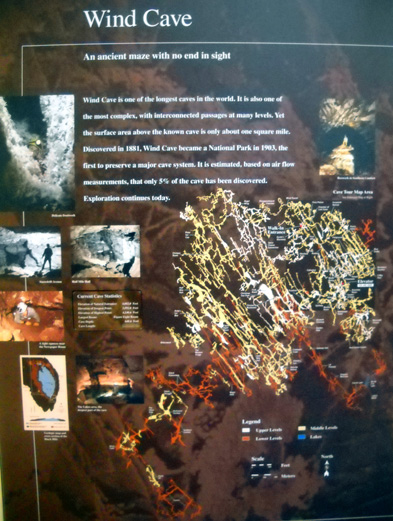
Diagram of known passageways within Wind
Cave
It was 2 PM by the time we got done with the second trail loop to
hunt for my lost keys. On the way back to the campground we stopped at
the visitor center to see if any more tours were available this
afternoon. Yes -- I could go on the Eden Tour at 3:30 PM or the
Natural Entrance Tour at 4 or 5 PM. I chose the 4 PM Natural Entrance
Tour so I'd have some time to take a shower and relax first.
All tours are ranger-guided and leave from the visitor center. You
can find details about each tour and the times they are available on the
park
website.
Tickets are sold on a first-come, first-served basis except for two
of the tours that require advanced registration (Candlelight and Wild
Cave). Those are lengthier, more strenuous tours over more rugged
terrain. They are limited to only ten people each and have minimum age
limits. The Wild Cave Tour involves spelunking and requires hard hats,
lights, kneepads, old clothes, gloves, and sturdy shoes, as much of the
4 1/2-hour trip requires crawling.
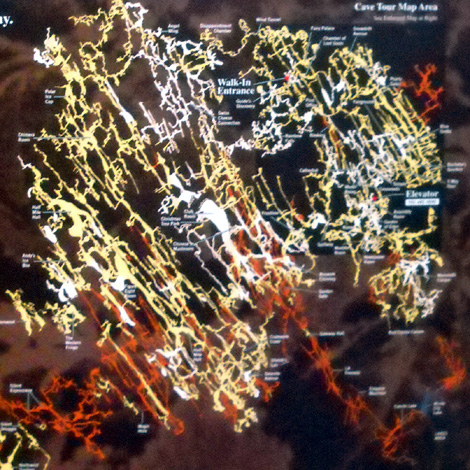
Detail of known passageways from
map above; there are more than this to the lower left.
The Natural Entrance, Garden of Eden, and Fairgrounds tours are less
strenuous but still require lots of steps down to the upper and middle
layers of the cave. They cover distances of up to one mile and last
60-90 minutes. The Fairgrounds Tour is the most strenuous of the three
and requires walking back out of the cave at the end; the Garden of Eden
Tour uses the elevator both into and out of the cave so it's the easiest
of the five tour options.
Because the cave remains a constant 53 F., visitors are encouraged to
wear a sweater or jacket even on hot summer days. Shoes are required on
all trails -- no sandals or bare feet. The cave trails are dimly
lighted and surfaces are uneven, wet, and slippery. Ceilings are
sometimes low, requiring some bending. There are some handrails, but not
many on the tour I took.
The website and park newsletter advise visitors to reconsider if they
get claustrophobic, have heart or respiratory problems, or "other
physical limitations."
There is a sixth tour options for visitors who have limited mobility. A
few areas of the cave are accessible to wheelchairs.
Photography is permitted in the cave, but not tripods. I had to
delete most of the photos I took because of their really poor quality. I
still use just a simple Coolpix L20 10-megapixel digital camera. Perhaps
I had it on the wrong setting, but without a tripod and special lenses I
couldn't get decent pictures underground.
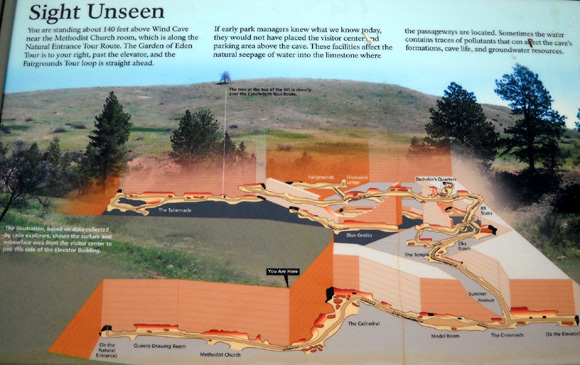
A diagram of various levels in
the cave; unfortunately, the visitor center, parking area, and
campground
were built above the cave and
there have been problems with water seeping down into the cave.
Cave tours range in
price from $5.00 to $23.00 per person over age
17. Kids, and folks with NPS senior passes, get in for half price. Check
the website for details. The popular Natural Entrance Tour, which I
took, is $9/adult without a senior pass, and $4.50 with the pass. It's
well worth either cost.
Keep in mind that there is no entrance fee to this national park.
The only things you pay for are the tours, camping, and/or books,
postcards, trinkets, etc. that you may want to purchase in the visitor
center. You can enjoy the scenery above ground, take a hike, have a
picnic, watch wildlife, enjoy all the displays at the visitor center,
etc. merely for the cost of gas to pass through the park.
HOW THE CAVE WAS FORMED
I'm interested in geology, so I'm going to include some really
ancient history about how this extensive cave was
formed. If you aren't
interested, scroll down to the next topic (what you'll see inside). My
information in this section comes from the park brochure; direct quotes
are in italics.
Wind Cave is one of the earth's oldest caves. Parts of the limestone
that constitute the upper levels of the cave were being dissolved into
passageways 320 million years ago. As ancient ocean levels
fluctuated, these passages were filled with sediments. Beneath the ocean
a thick layer of sediments continued to be deposited above that
limestone.
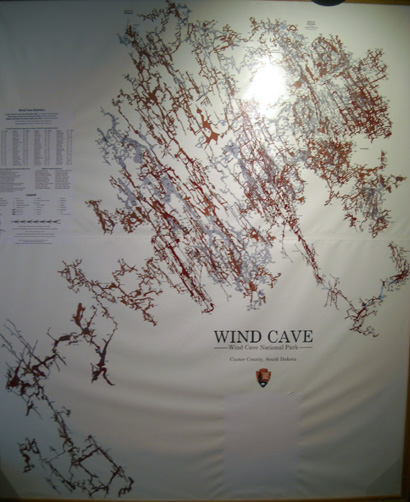
Another map of the cave passages
About 60 million years ago, the forces that uplifted the Rocky
Mountains also uplifted the modern Black Hills, producing large
fractures and cracks in the overlying limestone. Over millions of years,
water moving slowly through those cracks dissolved the limestone to
produce the complex maze of Wind Cave's passages.
Later erosion changed surface drainage patterns, which caused
subsurface water levels to drop, draining the cave passages.
As the modern Wind Cave formed, many of these newer passages
intersected the older filled cave, revealing the red clay and sandstone
sediments from 320 million years ago (our tour guide pointed some of
those out to us). A three-dimensional network of passes formed,
creating one of the most complex caves in the world.
BOXWORK & OTHER DELICATE FORMATIONS
Continuing to quote from the Wind Cave park brochure:
Also exposed were some of the most prominent features in Wind Cave
-- the boxwork -- thin, honeycomb-shaped structures of
calcite that protrude from the walls and ceilings:
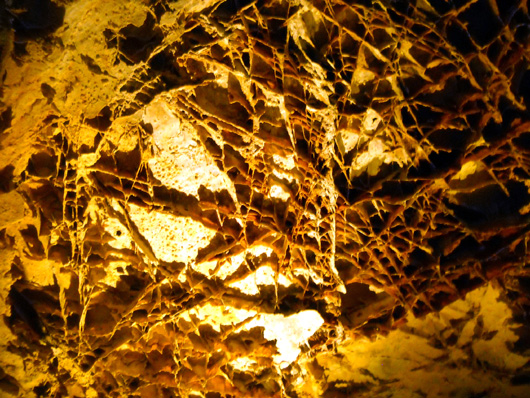
Although Wind Cave has few stalactites and stalagmites, many
unusual formations and a variety of minerals are found in the cave. The
complex geology of the cave, the profusion of boxwork, and the variety
of minerals make Wind Cave a world-class cave.
The boxwork I saw during my Natural Entrance Tour was fascinating.
I've been in some of the country's best caves, including Carlsbad
Caverns and Mammoth Cave, but I've never seen boxwork before. Very cool.
My tour guide explained boxwork in terms that were easy to understand
and convey to others.
Imagine a house built of sugar cubes. Something has to hold them
together -- mortar. If it rains, the sugar cubes dissolve but the
mortar remains. That's a great visualization of boxwork. Wind Cave
reportedly has 95% of all the known boxwork in the world, and very
possibly more that hasn't been found in the intricate cave system
yet to be explored.
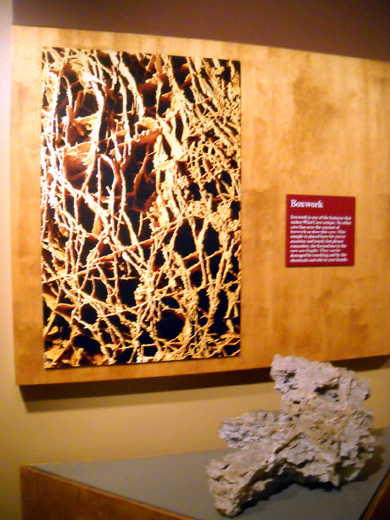
Part of the boxwork display at the visitor center
Wind Cave has other very interesting formations like frostwork and
popcorn, chocolate-colored crystals, flowstone (looks wet, and sometimes
is), formations resembling faces or
animals, and chambers that inspired the names they were later given.
These formations are both delicate and irreplaceable. You can guess
what happened as word got out from early cave explorers back in the late
1800s about the treasure trove within this cave.
When they were first discovered, streams of curious tourists were
drawn to the cave. Local entrepreneurs blasted open passes and guided
visitors through for a fee. Cave specimens were removed and sold.
The same thing has happened to so many other natural wonders in this
country. It's one of the few times I'm glad to see our government
intervene. Thankfully, Wind Cave has been protected since 1903 for
others to enjoy.
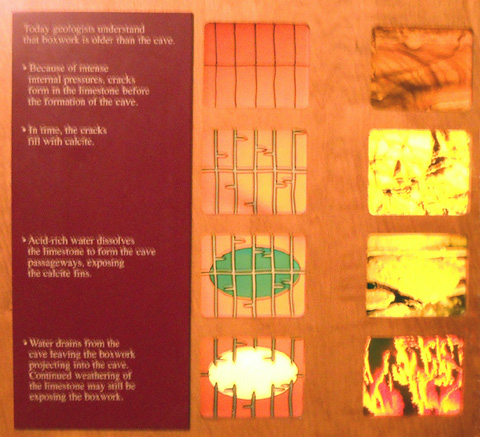
Visitor center display that
explains how boxwork forms
Rangers emphasize the delicate nature of the formations in every
pre-tour talk they give before taking visitors underground --
stay on the path and DO NOT TOUCH ANYTHING.
The park staff has a delicate balancing act to perform --
allowing visitors to enjoy these natural wonders while protecting the
very things visitors want to see.
One recent improvement is replacing outdated incandescent lighting in
the cave with LED and compact fluorescent bulbs. That not only cuts the
power bill, it also protects fragile cave formations because these bulbs
produce less heat. Water remains in the cave so crystals can grow and
there is less algae. I noticed on my tour that the lights are subtle yet
highlight features for which the cave is famous.
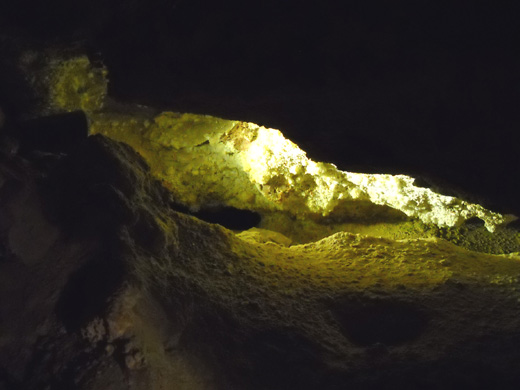
Subtle lighting
I was down far enough on my cave tour that no natural light could
penetrate the darkness. At one point the ranger had all of us stand
still. She turned off the lights and the darkness was absolute. So was
the silence (she asked us not to talk or move). That was pretty awesome.
Then she shone her light on various features like boxwork in the
chamber where we were standing. It was a spectacular demonstration. I
was sorry when she turned the lights on again!
THERE'S A FUNGUS AMONG US
Park staff has even more worries than protecting the delicate
geological features of the cave. Wildlife is a concern, too.
The park is justifiably paranoid about visitors bringing in a disease
called white-nose syndrome from outside South Dakota. This disease is
decimating bat populations in the eastern US. In just three or four
years it has spread to 15 states and Canada, killing over a million
bats. According to the park newsletter, "it is shaping up to be the
largest mass mortality event in North American wildlife in recorded
history."
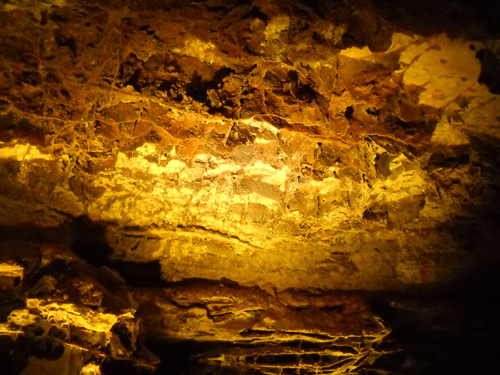
Another example of boxwork
Wind Cave hosts eleven different species of bats, eight of which are
cave-dwelling. The few bats seen in the cave are generally found along
the route I took, the Natural Entrance Tour. Our guide quickly shone her
light on a few as we passed through but did her best not to disturb them
any further.
Fortunately, none of the bats at Wind Cave are believed to have
contracted white-nose syndrome yet. Cave managers are keeping close tabs
on the situation, though. The fungus does not affect humans but humans
can spread the disease from cave to cave.
For this reason, visitors are asked to wear clean clothes and shoes
when touring Wind Cave, and not use gear that has been contaminated with
the disease in other caves.
All back-country caves at Wind Cave are closed to the public. They may
be entered only for management and research purposes.
COMMENTS ABOUT MY TOUR
I really enjoyed my Natural Entrance Tour with Ranger Maribeth
this afternoon. She's articulate, has a good sense of humor, and gave us a great tour.
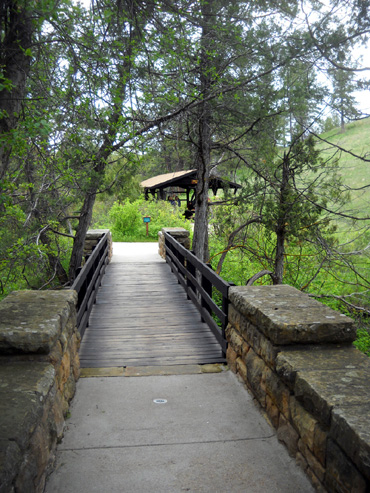
Walkway between the visitor
center and the cave tour assembly area
My group assembled in a covered area between the visitor center and
cave entrance so the ranger could introduce us to the cave, reiterate the
tour rules, and get us thinking about what we'd be seeing.
The group was larger than I would have preferred -- about 40
people, including perhaps 15 school-age kids and teens -- but it
moved along well through the passageways. I stayed near the front most
of the time so I could hear Maribeth better when she stopped us to talk
about cave features.
Our first stop was at the only natural opening to the cave, which I
mentioned above.
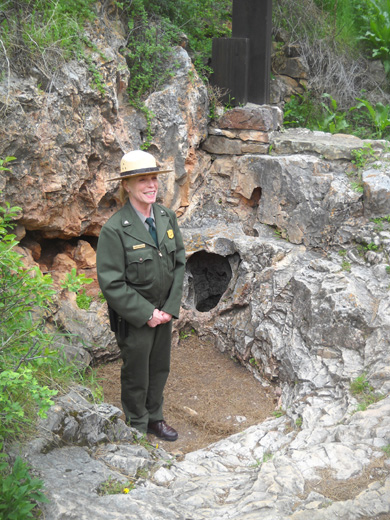
Ranger Maribeth shows us the only
natural entrance to the cave.
After demonstrating how much wind comes out of that small hole, we
went through a manmade entrance and gradually made our way down hundreds
of steps to the middle layer of the cave about 200 feet below ground.
The lowest explored level of the cave is 500 feet below the surface but
we didn't get down that far on this tour. We came back up on an
elevator.
Maribeth used her flashlight to highlight various features inside the
cave as we walked along, such as reddish rock colored by iron oxide. The
LED lighting is very subtle. She turned on more overhead lighting in two
places where she stopped to talk for a few minutes.
I mentioned earlier that she turned the lights off for a couple of
minutes. She did that to emphasize how difficult it was to explore or
tour the cave before artificial lighting was installed. It is amazing
how DARK it was 200 feet down when she turned off all the lights in our
vicinity!
The one time I ended up in the back of the pack was when Maribeth
asked me to stand still at a great example of "dogtooth slag" and shine
one of her flashlights on it while the rest of the group walked past me.
It looked like a big, beautiful geode with its crystalline features and
white "dog's teeth."
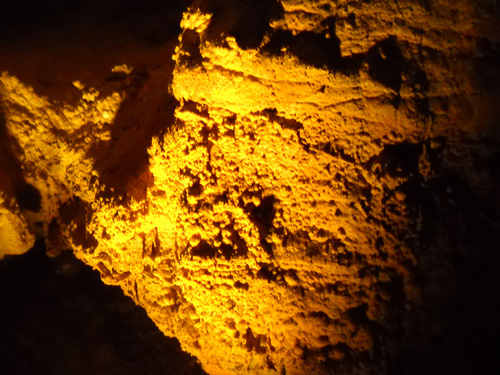
"Popcorn" formations
Unfortunately, none of the pictures I took of this feature came out
well. Here's a
link to a photo that does this
formation justice. There are additional links on that page for boxwork,
frostwork, popcorn, flowstone, and other "speleothems" in Wind Cave.
NEXT TIME
I want to return to Wind Cave for a longer period of time(s) in the
future so we can enjoy more of the trails and more of the cave tours.
I'm particularly interested in the Candlelight Tour, which takes
visitors to a less developed, unlighted part of the cave. Each person
carries a candle bucket for illumination. The tour lasts for two hours over one
rugged mile of trail. This year it is offered only from June 11 to
September 5. We won't be back by then in 2011, but maybe we can schedule
a visit to include that time span another year.

I highly recommend visiting Wind Cave NP if you're in the Black
Hills area.
This is a pretty laid-back, non-commercialized place to relax
and enjoy the scenery, wildlife, and unique geology. There is no
fee to enter the park and you can do many activities like
hiking, running, cycling, sightseeing, photography, picnicking,
etc. for free. Camping and cave tour fees are very reasonable
You could easily spend a week at Wind Cave NP and Custer State
Park, just to the north. There is more lodging available at
Custer SP. It also has lots of trails, bison, and interesting
scenery.
Next entry: the Dakota Thunder Air Show at
Ellsworth AFB in Rapid City, SD
Happy trails,
Sue
"Runtrails & Company" - Sue Norwood, Jim O'Neil,
and Cody the Ultra Lab
Previous
Next
© 2011 Sue Norwood and Jim O'Neil















